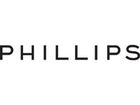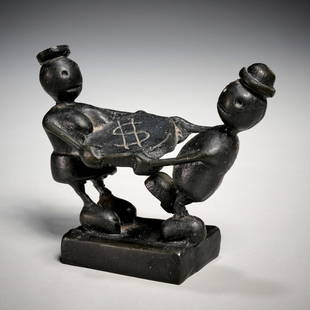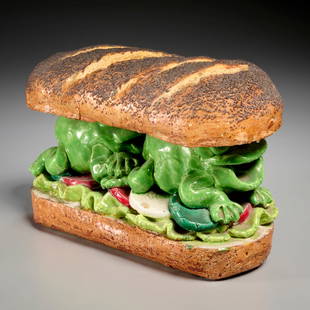
ANDY WARHOL, Statue of Liberty, 1986
Similar Sale History
View More Items in Statues & StatuettesRelated Statues & Statuettes
More Items in Statues & Statuettes
View MoreRecommended Sculptures & Carvings
View More


Item Details
Description
Statue of Liberty, 1986. synthetic polymer and silkscreen ink on canvas 72 x 72 in. (182.9 x 182.9 cm) Signed and dated “Andy Warhol 86” along the overlap.
PROVENANCE Galerie Lavignes Bastille, Paris Acquired from the above by the present owner, 1986
EXHIBITED Paris, Galerie Lavignes Bastille, Andy Warhol: Ten Statues of Liberty, April 8 – May 30, 1986
LITERATURE Andy Warhol: Ten Statues of Liberty, Paris, Galerie Lavignes Bastille, 1986, no. 8 (illustrated)
I’ve been going to Paris for about twenty years and I can’t even speak one word of French. I got away with it though. ANDY WARHOL (Andy Warhol in an interview with Jordan Crandall in Splash, No. 6, 1986, I’ll Be Your Mirror: The Selected Andy Warhol Interviews, edited by Kenneth Goldsmith, New York, 2004, p. 366). In 1986, during the centennial of the Statue of Liberty’s arrival in America, Andy Warhol executed his indelibly famous silkscreens employing the pattern of camouflage. In the present lot, Statue of Liberty, 1986, Warhol spins the colors of war into a tribute to international solidarity. Appropriating the historical pattern of violence and concealment, Warhol brilliantly rebrands camouflage as a stylistic statement. And, in doing so, he bequeaths the symbol of cooperation between the United States and France with an aesthetic grace that rivals any of his work from this prolific period in his life. The subject of the Statue of Liberty was not unfamiliar to Warhol. Having produced several photo collage silkscreens of the American icon during the early 1960s, Warhol, in the present lot, revisits a friendly acquaintance. Coming as a gift from the French sculptor Frederic-Auguste-Bartholdi in 1886, the Statue of Liberty ascends to a level of iconicity rivaled by few faces or objects in American history. It was a symbol of freedom: an allegory of the fraternal liberty of two nations. Consequently, she functions as a perfect recurring subject for Andy Warhol’s brand of Pop. Obtaining his original image from a postcard, Warhol employed his principle of reproduction with an image that had already scaled the heights of reproduction itself. The image of the Statue of Liberty had been a standard American cultural export for decades before Warhol began painting. Yet camouflage did not appear in Warhol’s paintings until more than twenty years later. Previous to 1986, Warhol had been working in a variety of techniques and stylistic formats, including the reversal series and the infamous oxidation paintings. But perhaps the most telling harbinger of his work with camouflage was the “shadow paintings”, which appeared with regularity throughout the decade leading up to 1986. In these paintings, we see his tendency for color-field patterns with varying shapes and border patterns. “Shape and shadow are the two principles most central to the concept of camouflage.” (B. Richardson, “Hiding in Plain Sight: Warhol’s Camouflage”, Andy Warhol: Camouflage, New York, 1998, p. 20). On a face already defined by the dramatic presence of shadow, Warhol’s camouflage pattern lends an exhilarating chromatic dimension. His canvas, six feet square, bears three layers of silkscreened image. The underlayer is composed of only the face and upper arm of the statue of liberty, resplendent in her classical glory. Here, Warhol exhibits a remarkable attention to detail in terms of the distribution of the paint and its equal distribution across the canvas; nowhere can we spot smudges or a visually unintelligible section due to oversaturation of pigment. Atop his original layer, Warhol lays his camouflage pattern. Crawling at every whim across the face of the statue and her outstretched arm, we behold four shades of lavender-blue that make the stern face even more intimidating. She looks as an enlisted soldier does, but instead, her mission is to pronounce the greatness of American liberty. But even as Warhol fortifies the Statue with a fierce resolve, his third layer of silkscreen is tongue-in-cheek: he inserts a label for the French cookie company, “Fabis”, into the lower right-hand corner of his picture. The image bears French and American flags flying together, corroborating the international solidarity represented by the Statue of Liberty with a delightful piece of kitsch. While we may be whisked away temporarily or perhaps even inspired by the Statue dressed in military garb, Warhol stamps his work with a comment on the commercialism for which he is known best; both France and America are trademarks, at peace with each other’s brand of business. In the present lot, Warhol also answers a common argument against his work and Pop Art in general; the unoriginality of readymade subjects. In his choice of camouflage as a motif, Warhol manages to exhibit impressions of myriad cultural visual traditions: “to call these paintings decorative would be short-sighted, for in manipulating the size, shape, and colors of traditional military fabric—a fabric designed not to be seen—he demonstrates an almost effortless ability to summon up an entire range of art historical references, from Chinese landscapes to Monet’s Water Lilies.”(B. Colacello, “Andy Warhol, Abstraction, and the Camouflage Paintings”, Andy Warhol: Camouflage, New York, 1998, p. 8). In addition, through the juxtaposition of camouflage with an omnipresent symbol of cultural iconicity, he achieves a subtle profundity: his work may not be politically motivated, but it is certainly a loaded painting. Statue of Liberty, 1986, has the benefit of being hotly suggestive but not prescriptive, which was one of Warhol’s many gifts as an artist. However, what begins to show through in the work executed close to his time of death was his unprecedented level of self-reflection. Later in the year, he even employed camouflage as a pattern over one of his many self-portraits. But we need not look so far for Warhol’s self-reference; in the craggy recessions and stoic lines on the face of the Statue, we observe Warhol’s own aging mask, weighted with connotations yet unwilling to yield any personal truth. Though the camouflage paintings give off Warhol’s common air of distance—an absence of the artist’s emotional involvement—they represent some of the artist’s most personal works. As a symbol himself, of freedom in art as opposed to a political liberty, Warhol lived in accordance with the usual function of his chosen pattern. “Warhol seems to have grasped this principle intuitively, dodging through life camouflaged whether in light or shadow, assuming the patterns of the varied backgrounds through which he moved.” (B. Richardson, “Hiding in Plain Sight: Warhol’s Camouflage”, Andy Warhol: Camouflage, New York, 1998, p. 20).
PROVENANCE Galerie Lavignes Bastille, Paris Acquired from the above by the present owner, 1986
EXHIBITED Paris, Galerie Lavignes Bastille, Andy Warhol: Ten Statues of Liberty, April 8 – May 30, 1986
LITERATURE Andy Warhol: Ten Statues of Liberty, Paris, Galerie Lavignes Bastille, 1986, no. 8 (illustrated)
I’ve been going to Paris for about twenty years and I can’t even speak one word of French. I got away with it though. ANDY WARHOL (Andy Warhol in an interview with Jordan Crandall in Splash, No. 6, 1986, I’ll Be Your Mirror: The Selected Andy Warhol Interviews, edited by Kenneth Goldsmith, New York, 2004, p. 366). In 1986, during the centennial of the Statue of Liberty’s arrival in America, Andy Warhol executed his indelibly famous silkscreens employing the pattern of camouflage. In the present lot, Statue of Liberty, 1986, Warhol spins the colors of war into a tribute to international solidarity. Appropriating the historical pattern of violence and concealment, Warhol brilliantly rebrands camouflage as a stylistic statement. And, in doing so, he bequeaths the symbol of cooperation between the United States and France with an aesthetic grace that rivals any of his work from this prolific period in his life. The subject of the Statue of Liberty was not unfamiliar to Warhol. Having produced several photo collage silkscreens of the American icon during the early 1960s, Warhol, in the present lot, revisits a friendly acquaintance. Coming as a gift from the French sculptor Frederic-Auguste-Bartholdi in 1886, the Statue of Liberty ascends to a level of iconicity rivaled by few faces or objects in American history. It was a symbol of freedom: an allegory of the fraternal liberty of two nations. Consequently, she functions as a perfect recurring subject for Andy Warhol’s brand of Pop. Obtaining his original image from a postcard, Warhol employed his principle of reproduction with an image that had already scaled the heights of reproduction itself. The image of the Statue of Liberty had been a standard American cultural export for decades before Warhol began painting. Yet camouflage did not appear in Warhol’s paintings until more than twenty years later. Previous to 1986, Warhol had been working in a variety of techniques and stylistic formats, including the reversal series and the infamous oxidation paintings. But perhaps the most telling harbinger of his work with camouflage was the “shadow paintings”, which appeared with regularity throughout the decade leading up to 1986. In these paintings, we see his tendency for color-field patterns with varying shapes and border patterns. “Shape and shadow are the two principles most central to the concept of camouflage.” (B. Richardson, “Hiding in Plain Sight: Warhol’s Camouflage”, Andy Warhol: Camouflage, New York, 1998, p. 20). On a face already defined by the dramatic presence of shadow, Warhol’s camouflage pattern lends an exhilarating chromatic dimension. His canvas, six feet square, bears three layers of silkscreened image. The underlayer is composed of only the face and upper arm of the statue of liberty, resplendent in her classical glory. Here, Warhol exhibits a remarkable attention to detail in terms of the distribution of the paint and its equal distribution across the canvas; nowhere can we spot smudges or a visually unintelligible section due to oversaturation of pigment. Atop his original layer, Warhol lays his camouflage pattern. Crawling at every whim across the face of the statue and her outstretched arm, we behold four shades of lavender-blue that make the stern face even more intimidating. She looks as an enlisted soldier does, but instead, her mission is to pronounce the greatness of American liberty. But even as Warhol fortifies the Statue with a fierce resolve, his third layer of silkscreen is tongue-in-cheek: he inserts a label for the French cookie company, “Fabis”, into the lower right-hand corner of his picture. The image bears French and American flags flying together, corroborating the international solidarity represented by the Statue of Liberty with a delightful piece of kitsch. While we may be whisked away temporarily or perhaps even inspired by the Statue dressed in military garb, Warhol stamps his work with a comment on the commercialism for which he is known best; both France and America are trademarks, at peace with each other’s brand of business. In the present lot, Warhol also answers a common argument against his work and Pop Art in general; the unoriginality of readymade subjects. In his choice of camouflage as a motif, Warhol manages to exhibit impressions of myriad cultural visual traditions: “to call these paintings decorative would be short-sighted, for in manipulating the size, shape, and colors of traditional military fabric—a fabric designed not to be seen—he demonstrates an almost effortless ability to summon up an entire range of art historical references, from Chinese landscapes to Monet’s Water Lilies.”(B. Colacello, “Andy Warhol, Abstraction, and the Camouflage Paintings”, Andy Warhol: Camouflage, New York, 1998, p. 8). In addition, through the juxtaposition of camouflage with an omnipresent symbol of cultural iconicity, he achieves a subtle profundity: his work may not be politically motivated, but it is certainly a loaded painting. Statue of Liberty, 1986, has the benefit of being hotly suggestive but not prescriptive, which was one of Warhol’s many gifts as an artist. However, what begins to show through in the work executed close to his time of death was his unprecedented level of self-reflection. Later in the year, he even employed camouflage as a pattern over one of his many self-portraits. But we need not look so far for Warhol’s self-reference; in the craggy recessions and stoic lines on the face of the Statue, we observe Warhol’s own aging mask, weighted with connotations yet unwilling to yield any personal truth. Though the camouflage paintings give off Warhol’s common air of distance—an absence of the artist’s emotional involvement—they represent some of the artist’s most personal works. As a symbol himself, of freedom in art as opposed to a political liberty, Warhol lived in accordance with the usual function of his chosen pattern. “Warhol seems to have grasped this principle intuitively, dodging through life camouflaged whether in light or shadow, assuming the patterns of the varied backgrounds through which he moved.” (B. Richardson, “Hiding in Plain Sight: Warhol’s Camouflage”, Andy Warhol: Camouflage, New York, 1998, p. 20).
Buyer's Premium
- 25% up to $50,000.00
- 20% up to $1,000,000.00
- 12% above $1,000,000.00
ANDY WARHOL, Statue of Liberty, 1986
Estimate $2,000,000 - $3,000,000
5 bidders are watching this item.
Shipping & Pickup Options
Item located in New York, NY, usSee Policy for Shipping
Payment

Related Searches
TOP














































































